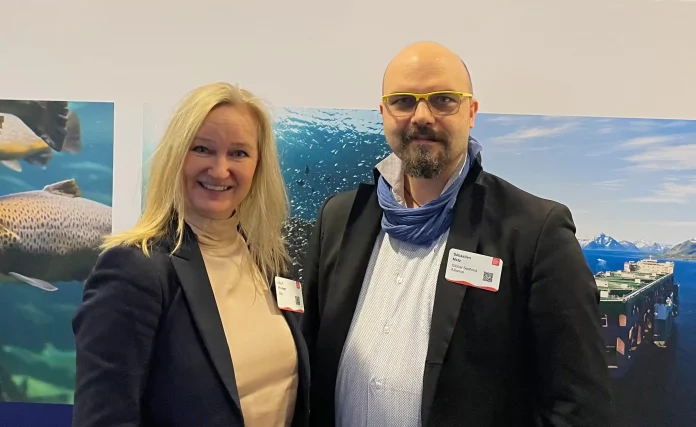Strategic partnership between DNV and GDST marks a pivotal step towards enhancing transparency and sustainability in seafood supply chains worldwide.
Quality assurance and risk management firm DNV has announced its collaboration with the Global Dialogue on Seafood Traceability (GDST) as a founder partner.
This partnership leverages digital technologies to track seafood throughout the supply chain, enhancing the reliability and integrity of seafood products globally.
Speaking to SalmonBusiness at the North Atlantic Seafood Forum in Bergen last week, Lisa de Jager, Global Aquaculture Sales and Marketing Director at DNV, and fisheries economist Sebastien Metz from GDST outlined the reasons for the alliance.
Illegal export of production fish distorting EU market says Danish Seafood Association
Headless chickens
“Over the past five or six years there have been a lot of traceability projects going on across the whole supply chain,” de Jager explained.
“Its been a bit like headless chickens, trying to find something that works. I don’t know how many billions that has been spent on finding the perfect solution,” she said.
The aim of the GDST will be to clean this process up, and ensure a harmonized approach, according to the DNV exec.
DNV’s current strategy focuses on five growth areas in aquaculture: animal welfare, integrity of farm installations and technology, biodiversity improvement, ESG (Environmental, Social, and Governance) initiatives and certification, and digitalisation and cyber risk management.
The partnership with GDST aims to harmonize data in the complex seafood supply chain to meet growing demands for food safety, transparency, and stakeholder requirements.
This initiative becomes crucial as aquaculture becomes an ever more important player in global supply chains ahead of 2050, de Jager told SalmonBusiness.
“There will be a lot of solutions out there. And it’s important that these solutions are able to speak to each other. And if you take a deep dive into retailers, they have interactions with thousands of suppliers. If we don’t base our traceability solution on an open platform and ensuring data interoperability, we will never manage to get this harmonised,” she said.
USB C?
Metz likens the process to the recent ruling by the European Union on phone chargers.
“Before, you would have 25 people in the room, with 20 different phone chargers, he said. “Now, even the largest non-European companies, have all integrated USB C. Its not about the technology you have inside your phone. It’s just how you plug it in, and GDST is a similar process. Basically some actors in the seafood sector realized that the issue is not about how seafood companies store their data, it is about how they communicate with each other.”
As Metz explained, digital solutions like blockchain are part of GDST’s strategy, but the focus is on interoperability among various systems rather than pushing for a single type of solution. The goal is to reduce complexity in tracing seafood products, particularly for retailers dealing with multiple suppliers.
“The key example is, how do you record the name of the fish?” he asked, rhetorically. “You could record it in Norwegian and French, or in Latin. And already, you have an issue there, because even in French, one name is often actually five different fish. And I suspect in Norwegian and English the problem is the same. So just that is a logistic and traceability nightmare for people. Having standardized taxonomy is essential.”
DNB links borrowing costs to welfare goals as bank exec calls mortality crisis ‘unacceptable’
Building bridges
Another key challenge GDST addresses is how data is transferred when seafood is moved in and out of different systems. GDST proposes a standard approach to streamline this process, reducing the need for multiple customized solutions or “bridges” to pass data, thus simplifying seafood traceability.
“It’s really about solutions interoperability and trusted data,” explained de Jager. “The question in the end is how to understand and trust the information tag on the seafood, how do you pass on the value added data? And what bridge do you have to make? Currently, operators along the supply chain have to build a lot of bridges. The whole idea of GDST is to avoid this cost-driven bridging by standardising or streamlining data flows and enabling benchmarking on seafood across the supply chain. The GDST ‘bridge’ will improve return on investment on your traceability solution.”
To accommodate this bridge building, DNV is incorporating proven GS1 standard solutions, building on years of experience from other sectors e.g. traceability of medicines, food products, fashion etc and now also into aquaculture, and preparing their traceability solutions to be compliant with the Global Dialogue on Seafood Traceability (GDST) standards, said de Jager.
FDA Food Safety Modernization Act
DNV’s digital Solution Partners on traceability and compliancy such as Kezzler must commit to GDST standard for Aquaculture. This approach is driven by the network effect of global reccognized standards: the more entities follow them, the more they become a prerequisite.
The evolving requirements for product traceability and recall in the seafood industry are central to the conversation. Retailers are keen on communicating product safety and origins to consumers, notes de Jager. The US FDA Food Safety Modernization Act (FSMA 204) as an example has introduced stringent new regulations, requiring retailers to trace and announce the targeted recall of products within two days, effective from jan 2024. This change poses substantial operational challenges for the industry.
Against this backdrop, DNV’s collaboration with GDST is a significant step toward simplifying seafood traceability. This partnership aims to establish a more unified, efficient, and reliable seafood supply chain, which is crucial for addressing the growing global demands in the lead-up to 2050.









